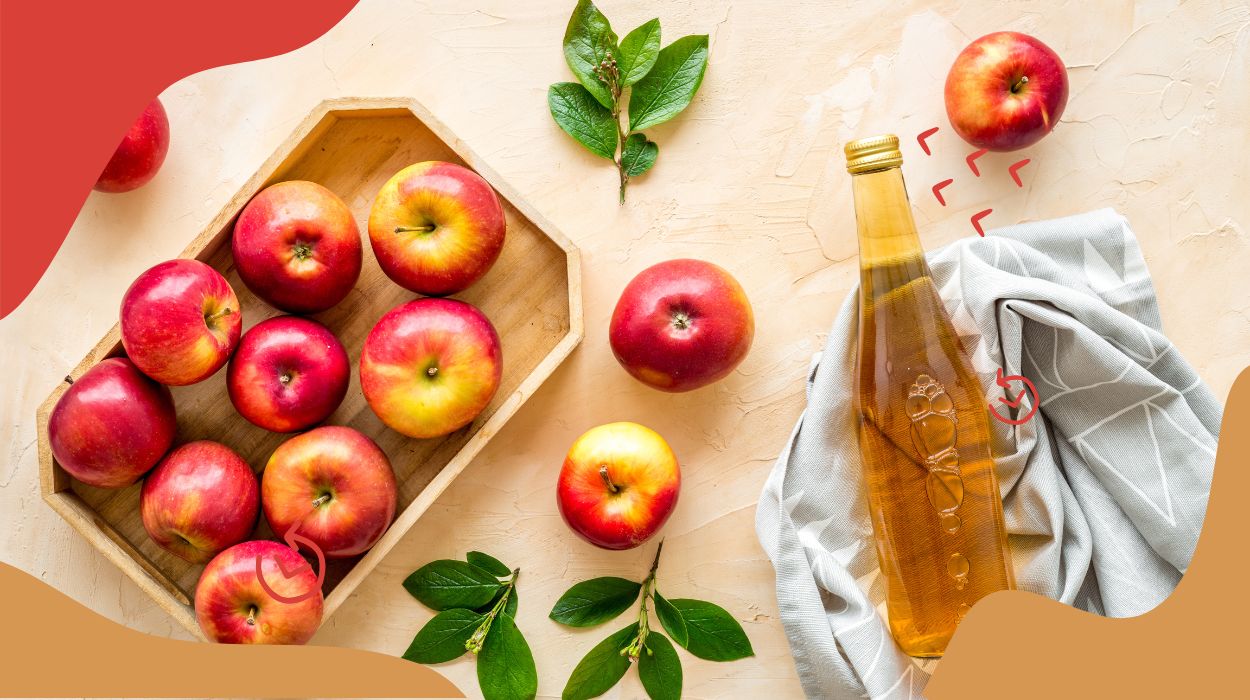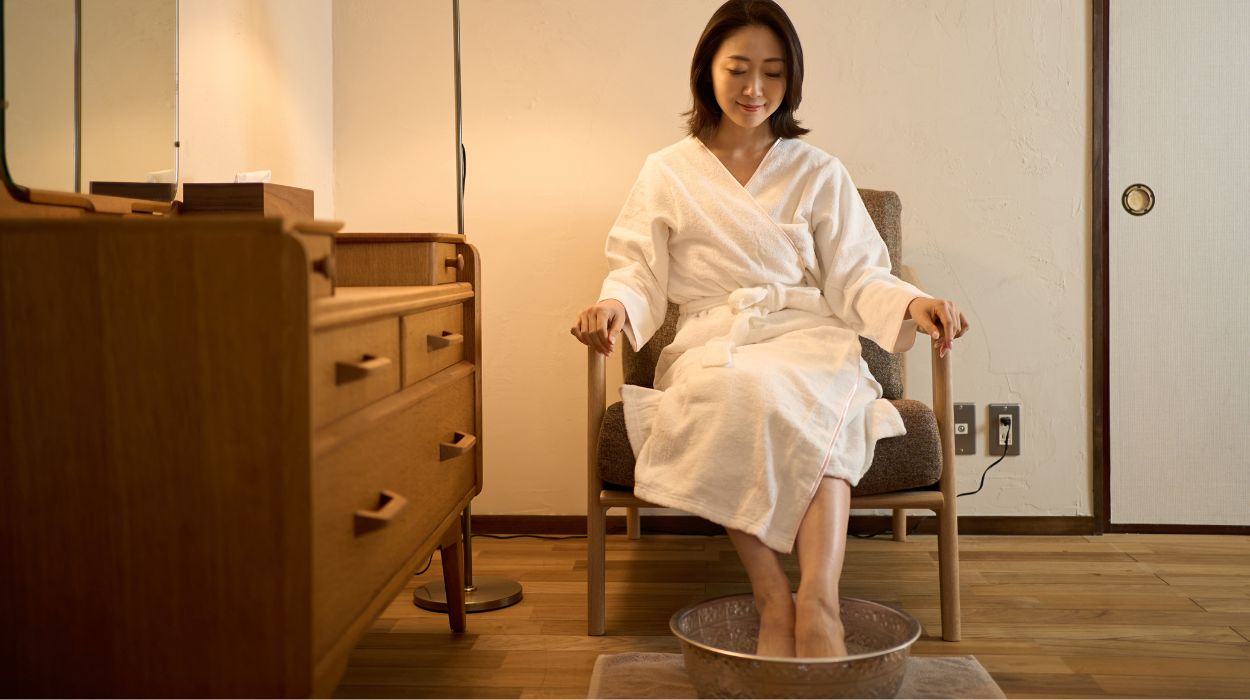 Expert's opinion
Expert's opinion
Expert's opinion
The article is a subjective view on this topic written by writers specializing in medical writing.
It may reflect on a personal journey surrounding struggles with an illness or medical condition, involve product comparisons, diet considerations, or other health-related opinions.
Although the view is entirely that of the writer, it is based on academic experiences and scientific research they have conducted; it is fact-checked by a team of degreed medical experts, and validated by sources attached to the article.
The numbers in parenthesis (1,2,3) will take you to clickable links to related scientific papers.
Wrapping Feet In Apple Cider Vinegar To Lose Weight: How To Do It 2024?

Wrapping Feet In Apple Cider Vinegar To Lose Weight – Did you know the Babylonians first used vinegar around 5,000 BCE to preserve food? About 2,000 years later the Egyptians were also using it. Even Hippocrates used it in treating his patients back in 400 BCE Greece. None of this is surprising, as apple cider vinegar is known to have over 100 different uses such as soaking feet in apple cider vinegar for weight loss.
Among many other examples, apple cider vinegar (ACV) has been known to ease an upset stomach, help lower blood sugar levels[1], and reduce cholesterol[2]. Does apple cider vinegar help blood flow? Yes, it even improves circulation by controlling lipids in the bloodstream, decreasing inflammation, and discouraging atherosclerosis, and these pro-circulatory changes help toward healthier skin circulation! This benefit is especially true in diabetics who suffer from foot ulceration and neuropathic pain (so for them, add the ACV benefit of controlling blood sugar). Certain bacterial infections[3] like E. coli and Staphylococcus (Staph) are no match for ACV. Apple cider vinegar even has anti-inflammatory properties that can help with issues like joint pain.
How is this fantastic remedy made? It’s made from the fermentation of basic apple juice. The details involve mixing the juice with yeast and water and keeping the mixture at room temperature for 30 days. The yeast turns the sugar into alcohol, and bacteria change the alcohol into vinegar. Now we know that apple cider vinegar has many uses, but can it help you lose weight? And can this be done by soaking your feet in apple cider vinegar to lose weight?
Does Soaking Feet In Apple Cider Vinegar For Weight Loss Work?
There isn’t any conclusive evidence yet that soaking your feet in apple vinegar works for weight loss. Studies[4] have shown that ACV foot soaks do not alter the integrity of the skin barrier at all, which means there are no absorbed systemic effects on any other parts of the body. However, ingesting it is a completely different story. It can be helpful with weight reduction[5]. A 2009 study[6] concluded that drinking apple cider vinegar may help prevent or reduce obesity.
Thus, soaking the feet won’t address concerns in the rest of the body, but it will have a local effect on the feet, i.e., anti-bacterial and anti-fungal to control foot odor, soften calluses, etc. More on this below.
Soaking Feet In Vinegar For Weight Loss – How you do it?

- When preparing a foot bath, you’ll want to get a large bowl or basin if possible. If not, you can always use your tub.
- There’s no one way to go about making your own apple cider vinegar foot soak. However, the general rule seems to be to have two parts warm water for everyone part apple cider vinegar.
- Alternatively, you can try mixing ⅓ of a cup of ACV, 2 cups of water, and ⅓ cup of Epsom salts. This will work best in a basin or large bowl. (Epsom salts are a salt of magnesium, which will help reduce swelling and soothe the skin.)
Try both kinds of soaks and see which one you like best!
Other Health Benefits
Acetic acid, the main component of apple cider vinegar, has numerous health benefits for the body. It’s been known to suppress the areas of the brain that control appetite, and when this happens, you’ll have less of a desire to eat. Acetic acid also decreases fat storage, especially in the stomach and liver, and it’s been known to burn fat as well. Thus, its anti-obesity effects are multifaceted–lowers blood sugar, decreases fat storage, and burns fat; it also helps with the even darker side of obesity–mitigating the risk of atherosclerosis and heart disease.
ACV is also an anti-oxidant[7], which gives it anti-cancer and anti-aging properties.
How to drink apple cider vinegar
Many people find ACV to be too strong to drink at full strength, and if this is you, try adding a few tablespoons to a salad. You could also mix a tablespoon into your tea or make your tonic by adding it to a cup of warm water, ginger, and honey.
Dilution is also a good idea if you value the enamel on your teeth, which the acidic nature of ACV can erode.
The popular remedies for which ACV foot soaks are used include the following:
Helps Eliminate Foot Odor
Bacteria cause stinky odors on our bodies and feet. These sneaky guys like to grow in dark places that get hot and sweaty, and feet are the perfect combination of all three. The acetic acid in apple cider vinegar kills the bacteria that thrive in that ideal environment.
One study[8] even showed ACV reduced Staph (MRSA) and resistant E. Coli bacterial infections on the skin. If you do have one of these infections, it’s best to seek the advice of a health professional before embarking on your treatment plan.
Gets Rid of Athlete’s Foot
Fungal infections like Athlete’s Foot is very common, especially among runners, and people engaged in activities that cause foot perspiration. Both fungus and bacteria live on normal, healthy skin and make a sort of ecosystem there. However, they can cause trouble when they get out of control or if one species dominates within that ecosystem. Both bacteria and fungi love warm, moist places, and adding shoes just makes it better for them. Fungus, especially, thrives between the toes, which is where Athlete’s Foot usually starts. A good preventative measure against toe fungus is to be sure to dry your toes in between each one after a shower, bath, or even an ACV foot soak.
Apple cider vinegar has been shown[9] to kill Candida albicans yeast, which causes Athlete’s Foot. This is especially helpful when the infection has become resistant to antifungal medicine. Soak your feet once a day for about 20 minutes until they’re healed.
Softens Calluses
Calluses are caused by frequent friction in one area. If your shoe constantly rubs up against a particular part of your foot, for instance, the skin will thicken there. It’s the skin’s way of protecting itself from further damage by thickening the skin barrier. Apple cider vinegar can help get rid of unsightly calluses safely and efficiently while you pursue the original cause (the wrong shoes!).
Apple cider vinegar’s natural exfoliating properties remove dead skin cells. You can thank the alpha-hydroxy acids[10] it contains for that! Now new skin cells can grow, making your skin look and feel smoother. So skip the expensive trip to the spa and go for this DIY foot soak. Give your feet a swim for about 25 minutes at least once a week and follow with a moisturizer. And dry between the toes after!
Gets Rid of Toenail Fungus (But This Is a Myth)
Toenail fungus can creep in from surface fungal infections on the foot, especially when nails get older and more brittle. As they become dry and cracked, it allows the fungus to invade the nail structure itself. This is how Athlete’s Foot sometimes can lead to toenail fungus when you will find that your nails look yellow and get thicker than usual.
Even though apple cider vinegar has antifungal properties, it cannot kill toenail fungus. Fungal infection in the nails is much deeper than the skin surface where simpler Athlete’s Foot occurs. As such, it is a more complicated infection, requiring a prescription from a professional healthcare provider. The best treatment for nail fungus is prevention, by using acetic acid in ACV to prevent the fungus from growing on the skin surface such that it cannot then spread into the nail. Dip your feet in an ACV bath at least once a week for about 25 minutes.
What Can You Do To Have Additional Benefits With Apple Cider Vinegar?
Combining baking soda with your apple cider vinegar foot soak for extra odor-fighting and exfoliation properties may seem like a good idea, but this may be a myth. Baking soda has a pH of 9, which counteracts the acid benefits of ACV. You may just be borrowing from Peter to pay Paul! Baking soda can disrupt the skin’s natural pH (4.5-5.5), causing skin that can be sensitive to many things–including ACV!
According to the Indo-American Journal of Pharmaceutical Research[11], using witch hazel, toothpaste, lemon juice, or baking soda to help the skin remains a popular myth, as they merely irritate the skin; others, including coconut oil, apple cider vinegar, aspirin, and rose water, enrich the skin.
Some people use Epsom salts to help ease aching feet, thinking that some muscle soreness is caused by a magnesium deficiency. Remember that skin integrity limits how much your skin soaks up magnesium, so thinking this may be a stretch.
Oils are an excellent addition to your ACV foot soak, and certain oils are better than others when used in warm water. Jojoba oil will help soften and moisturize the skin both during and after the bath. The skin easily absorbs both jojoba and apricot kernel oils. Sweet almond oil is a light, effective skin moisturizer.
Essential oils are popular for aromatherapy, and many have medicinal properties as well. Add a few drops of lavender or chamomile to help you relax. Tea tree oil, also known as melaleuca oil, has antifungal properties. So, you may want to use it if you have Athlete’s Foot. You could also try invigorating peppermint oil to soothe aching feet with its anti-inflammatory properties.
Virgin coconut oil[12] enhances skin integrity and has antimicrobial and antioxidant properties that can relieve itching.
Final Thought
While apple cider vinegar provides a host of body and skin benefits, it’s always a good idea to be aware of side effects, too. When applied to the skin, it may cause burning or rashes no matter your skin type. To help avoid this, test a small area with a diluted ACV and water mix in a spray bottle and spritz it on the skin. Wait a few minutes to see what happens before applying the full regimen. Taken orally, beware of the risk to your tooth enamel or possible stomach irritation.
Whether you’re looking to lose weight or put an end to foot odor, apple cider vinegar by mouth or as a foot soak, respectively, can help. A soak after a run can help keep Athlete’s Foot at bay. Get a good night’s sleep by sprinkling a few drops of snooze-inducing lavender in your ACV foot bath. Maybe that’s what the pharaohs did to ease their stress back in Egypt!
+ 12 sources
Health Canal avoids using tertiary references. We have strict sourcing guidelines and rely on peer-reviewed studies, academic researches from medical associations and institutions. To ensure the accuracy of articles in Health Canal, you can read more about the editorial process here
- Hlebowicz, J., Darwiche, G., Björgell, O. and Almér, L.-O. (2007). Effect of apple cider vinegar on delayed gastric emptying in patients with type 1 diabetes mellitus: a pilot study. BMC Gastroenterology, [online] 7(1). Available at: https://link.springer.com/article/10.1186/1471-230X-7-46
- Beheshti, Z., Yiong Huak Chan, Hamid Sharif-Nia and Yiong Huak (2012). Influence of apple cider vinegar on blood lipids. [online] ResearchGate. Available at: https://www.researchgate.net/publication/260311324_Influence_of_apple_cider_vinegar_on_blood_lipids.
- Yagnik, D., Ward, M. and Shah, A.J. (2021). Antibacterial apple cider vinegar eradicates methicillin resistant Staphylococcus aureus and resistant Escherichia coli. Scientific Reports, [online] 11(1). Available at: https://pubmed.ncbi.nlm.nih.gov/33473148/
- Luu, L.A., Flowers, R.H., Kellams, A.L., Zeichner, S., Preston, D.C., Zlotoff, B.J. and Wisniewski, J.A. (2019). Apple cider vinegar soaks [0.5%] as a treatment for atopic dermatitis do not improve skin barrier integrity. Pediatric Dermatology, [online] 36(5), pp.634–639. Available at: https://onlinelibrary.wiley.com/doi/abs/10.1111/pde.13888
- Khezri, S.S., Saidpour, A., Hosseinzadeh, N. and Amiri, Z. (2018). Beneficial effects of Apple Cider Vinegar on weight management, Visceral Adiposity Index and lipid profile in overweight or obese subjects receiving restricted calorie diet: A randomized clinical trial. Journal of Functional Foods, [online] 43, pp.95–102. Available at: https://www.sciencedirect.com/science/article/abs/pii/S1756464618300483
- KONDO, T., KISHI, M., FUSHIMI, T., UGAJIN, S. and KAGA, T. (2009). Vinegar Intake Reduces Body Weight, Body Fat Mass, and Serum Triglyceride Levels in Obese Japanese Subjects. Bioscience, Biotechnology, and Biochemistry, 73(8), pp.1837–1843.
- Budak, N.H., Ozçelik, F. and Güzel-Seydim, Z.B. (2015). Antioxidant Activity and Phenolic Content of Apple Cider. Turkish Journal of Agriculture – Food Science and Technology, [online] 3(6), p.356. Available at: http://agrifoodscience.com/index.php/TURJAF/article/view/265
- Yagnik, D., Ward, M. and Shah, A.J. (2021). Antibacterial apple cider vinegar eradicates methicillin resistant Staphylococcus aureus and resistant Escherichia coli. Scientific Reports, [online] 11(1). Available at: https://pubmed.ncbi.nlm.nih.gov/33473148/
- Biocoreopen.org. (2018). The effect of Apple Cider Vinegar (ACV) as an antifungal in a diabetic patient (Type II Diabetes ) with intraoral candidosis (A Case Report). [online] Available at: https://biocoreopen.org/ijdoh/The-Effect-of%20Apple-Cider-Vinegar-ACV-as-an-Antifungal-in-a-Diabetic-Patient.php
- Tang, S.-C. and Yang, J.-H. (2018). Dual Effects of Alpha-Hydroxy Acids on the Skin. Molecules, [online] 23(4), p.863. Available at: https://www.ncbi.nlm.nih.gov/pmc/articles/PMC6017965/
- Sankar, R. (2020). ACNE-CAUSES AND AMAZING REMEDIAL MEASURES FOR ACNE. [online] ResearchGate. Available at: https://www.researchgate.net/publication/340874478_ACNE-CAUSES_AND_AMAZING_REMEDIAL_MEASURES_FOR_ACNE.
- Liza, A. and Vermen Verallo-Rowell (2004). A Randomized Double-Blind Controlled Trial Comparing Extra Virgin Coconut Oil with Mineral Oil as a… [online] ResearchGate. Available at: https://www.researchgate.net/publication/8009961_A_Randomized_Double-Blind_Controlled_Trial_Comparing_Extra_Virgin_Coconut_Oil_with_Mineral_Oil_as_a_Moisturizer_for_Mild_to_Moderate_Xerosis



